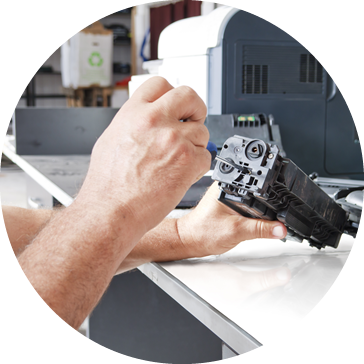How The Laser Printer Works.
Laser printers are truly amazing machines. Think about it: They accept an input of electrical pulses through a wire with a fancy plug. Seconds, mere seconds, later they eject a perfectly printed document. That document can include any number of fonts, lines, illustrations, and photographs.
To the uninitiated, it looks like a miracle Demystifying the miracle is the first step toward becoming a qualified repair technician. While it may not be strictly necessary to understand something to fix it -you fix your headache by taking an aspirin, but you don't understand what's happening in your brain-true confidence and competence in your technical abilities will only come with a thorough understanding of the way the printer operates.
Often on a repair call, I can determine what is wrong and what I'm going to do just by listening to the printer go through its cycle. Invariably, I can form a detailed diagnosis after the machine has printed, or at least tried to print, a page. I can do this because I am intimately familiar with the way the machine operates, intuitively and intellectually.
THE XEROGRAPHIC PROCESS-AN "OLD" INNOVATION
Xerography has been around and popular for 30 years. The principles of using toner to develop an image are so well understood, it's surprising that laser printing wasn't developed earlier. The first HP LaserJet was developed based on the PC 25 copier.
The Nature of Selenium Xerography became possible when it was discovered that the element selenium had peculiar electrical characteristics. It had the capability of receiving and storing a localized charge when confronted with high voltage. Even more interesting, it was found that light would dissipate the accepted charge. Tests indicated that a charged sheet of selenium-coated aluminum (or any other suitable base metal) would release its charge when struck by light, only in the area exposed to the light and proportionate to the intensity of the exposure, providing there was a ground path.
This created the opportunity to use static charges in the photographic process, as the electrostatic image created by light on the charged field was analogous to a photographic negative.
To the uninitiated, it looks like a miracle Demystifying the miracle is the first step toward becoming a qualified repair technician. While it may not be strictly necessary to understand something to fix it -you fix your headache by taking an aspirin, but you don't understand what's happening in your brain-true confidence and competence in your technical abilities will only come with a thorough understanding of the way the printer operates.
Often on a repair call, I can determine what is wrong and what I'm going to do just by listening to the printer go through its cycle. Invariably, I can form a detailed diagnosis after the machine has printed, or at least tried to print, a page. I can do this because I am intimately familiar with the way the machine operates, intuitively and intellectually.
THE XEROGRAPHIC PROCESS-AN "OLD" INNOVATION
Xerography has been around and popular for 30 years. The principles of using toner to develop an image are so well understood, it's surprising that laser printing wasn't developed earlier. The first HP LaserJet was developed based on the PC 25 copier.
The Nature of Selenium Xerography became possible when it was discovered that the element selenium had peculiar electrical characteristics. It had the capability of receiving and storing a localized charge when confronted with high voltage. Even more interesting, it was found that light would dissipate the accepted charge. Tests indicated that a charged sheet of selenium-coated aluminum (or any other suitable base metal) would release its charge when struck by light, only in the area exposed to the light and proportionate to the intensity of the exposure, providing there was a ground path.
This created the opportunity to use static charges in the photographic process, as the electrostatic image created by light on the charged field was analogous to a photographic negative.



